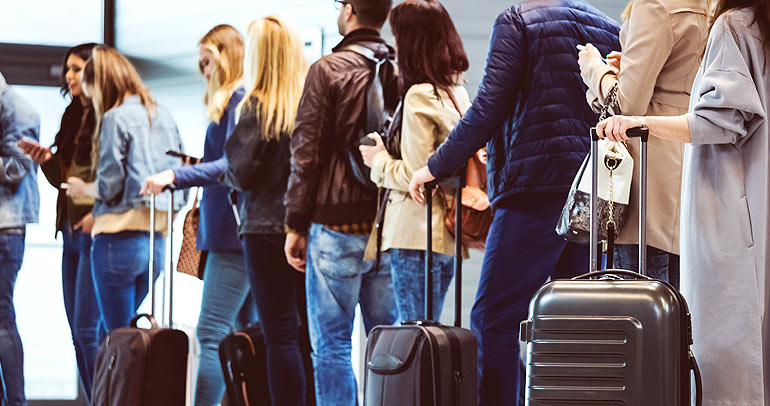
The global travel and tourism industry sits smack in the eye of a perfect storm. On the one hand, demand is up. Planes are packed. Our wanderlust is lustier than ever. On the other hand, rising inflation, lagging infrastructure, geopolitical uncertainty, staffing shortages, and COVID’s lingering impact have all converged into the stuff of nightmares — for travelers and the travel industry alike.
As researchers and advisors to global tourism boards and brands across the travel and tourism ecosystem, we are seeing some of these challenges hit certain players harder than others. On the bright side, recovery is on the horizon. But some geographies and industry sectors will face steeper challenges as five major headwinds converge upon them. We’re seeing opportunities for brands to get ahead of the storm and put the wind at their back.
These are the top five challenges facing the travel and tourism industry today, along with our perspective on navigating the way forward.
Travel Insight #1: Inflation means trade-offs and discretionary travel may lose out
Just when tourism was on the rebound, rising inflation came nipping at the heels of a travel boom. Escalent’s forthcoming 2022 Holiday Shopping & Travel Study revealed only 42% of consumers feel confident they’ll achieve their 2022 holiday travel plans (down 24 percentage points from 2021), and 49% of consumers are uncertain their holiday plans will be achieved (up 23 percentage points from 2021).
For the travel and tourism industry, inflation is a huge concern since it drives up product prices and affects consumers’ willingness to spend on discretionary travel. According to Euromonitor, 63% of travel executives said inflation was having a moderate to extensive impact on their businesses. Subsequently, over half of global travel companies acted in kind, by raising all or some of their prices. This was even higher in the Americas, where 59% of the companies raised all or some of their prices. Meanwhile, 44% of businesses accepted that they would suffer from having a lower profit margin by absorbing the inflationary costs rather than passing them on to their consumers to limit impact on their travel plans.
During inflationary times, it is common to see brands cut back on their marketing and advertising spend. While this reduces costs short term, it can be a setback to building long-term brand trust. In times of uncertainty, consumers tend to gravitate towards certainty, something a trusted brand can confer. And a destination is a brand. The more trust you can build amid uncertainty, the better.
Travel Insight #2: The ripple effects of geopolitical disruption
Geopolitical instability is also a key concern for the travel and tourism industry. The outlook for global travel and tourism for inbound spending is expected to be at 45% of 2019 levels, according to Euromonitor’s travel forecast model. The war in Ukraine is estimated to have caused a $7 billion decline in global inbound tourism, while Russian outbound tourism has all but collapsed under economic sanctions, airspace closures and flight bans. The loss of big-spending Russian visitors will impact travel destinations globally, but especially in Europe, the Caribbean and Turkey.
What happens when your high-value source market can’t travel? The ripple effects of geopolitical disruption are felt across regional clusters, forcing travel and tourism entities to rethink their source markets and reset their tourism marketing and targeting strategy.
Travel Insight #3: The travel and tourism infrastructure is in trouble
The pent-up travel demand is causing additional strain on the existing infrastructure, particularly for the airline sector. Problems with safety protocols and compliance with new national and international health standards are predicted to be made worse by capacity constraints when the industry recovers. This is expected to result in (even) longer lines, (more) crowded terminals and operational bottlenecks.
Social distancing measures have been lifted in many countries, including the US. But measures are still in place in many airports around the world, thus reducing airport capacity. Airports that operated close to their saturation capacity before the COVID crisis can expect to reach their maximum saturation capacity at just 60%–75% of their pre-COVID peaks.
According to ACI World, as air transport demand recovers, passenger demand will put more pressure on existing airport infrastructures. This may have socio-economic consequences, if not addressed in time. If long-term capacity constraints are not addressed through capital investments, it is estimated to lead to a reduction of up to 5.1 billion passengers globally, by 2040. For every million passengers that airports cannot accommodate due to airport capacity constraints in 2040, there would be 10,500 fewer jobs and 346 million USD less in GDP contribution from the industry.
Airports are often the “first impression” of a destination. A traveler’s airport experience sets the stage for the rest of the journey. When greeted with chaos and delays, even the most intrepid traveler can sour on the experience. Recently the US has made modest steps towards infrastructure improvement, including the Infrastructure Investment Act passed in November 2021, which includes spending for airports. While its impact will not be immediately felt, many travel associations have applauded the passing of this long overdue legislation.
Travel Insight #4: There’s no quick fix for the staffing shortage
If you’ve stepped foot in an airport this summer, you already know. The travel industry is facing a severe staffing challenge, particularly for customer-facing roles at hotels and airlines. Industry CEOs acknowledge that they are struggling to add staff to meet demand.
Airlines, in particular, are struggling to fill staffing requirements. Boeing’s 2021 Pilot and Technician Outlook voices concern that many airline workers who were furloughed during COVID may have left the industry permanently. The commercial airline industry needs 612,000 new pilots, 626,000 new maintenance technicians and 886,000 new cabin crew members over the next 20 years. Hotels and hospitality are also struggling, making it harder to deliver on guests’ expectations. Many hotels are shifting housekeeping services to a by-request-only model and some are cutting back on food and beverage amenities, including room service and restaurants.
What’s the precautionary tale to take away from this staffing mess? It can take decades to build brand trust, and one canceled flight, one bad stay, to destroy it. How people experience your brand — no matter if it’s in the best of times or the worst of times — stays with them. Travelers expect consistency from major brands. It will take time and investment for many airline and hospitality brands to rebuild trust in the quality and consistency of their brand experience.
Travel Insight #5: COVID is with us for the long haul
COVID travel restrictions are still impacting many elements of world tourism, with countries like China continuing to impose stringent restrictions and quarantines on visitors as well as Chinese outbound travelers.
In Asia Pacific, 83% of travel businesses report that ongoing COVID restrictions continue to have a moderate to extensive impact. This compares with 59% in Western Europe, according to Euromonitor. Although less, compared to 2021 levels, COVID concerns among travelers persist. Ongoing concerns, including new variants, affect the travel decisions of 55% of travelers, according to another recent study. Travelers are planning their trips cautiously, and nearly 70% are avoiding certain destinations, with 56% preferring close destinations and 56% avoiding crowded places.
Just as sanctions have grounded Russian travelers, COVID restrictions are keeping Chinese travelers homebound. Popular destinations for Chinese tourists such as Japan, Thailand, Singapore and Australia continue losing out on billions in tourism revenue. And countries with strict quarantine requirements like Japan continue to struggle. Between June 10 and July 10 this year, Japan hosted only 1,500 international tourists, according to data from Japan’s Immigration Services Agency. That’s down 95% from the same period in 2019. Who wants to spend half their holiday in quarantine? Destinations like Japan have focused on promoting domestic travel, but with COVID with us for the long haul, doubling down on domestic travel marketing and promotions is not a sustainable strategy.
Turn disruption into opportunity with tourism industry research and consulting
Escalent specializes in travel and tourism market research, traveler behavior, tourism investment strategy and consultative support across the travel and tourism ecosystem. Learn more about our Travel & Tourism practice and let us help you ride out the storm and go forth with confidence.
SOURCES CITED
(forthcoming) Escalent 2022 Holiday Shopping and Travel Study Please contact us if you would like to be notified when the report is available. View press release.
Voice of the Industry: Travel Survey, Facing New Challenges, Euromonitor, May 2022
Travel: Quarterly Statement Q1 2022, Euromonitor, May 2022
Holiday Barometer among Europeans, North Americans, Asians & Oceanians, Ipsos, June 2022
Japan is open to travel. So why aren’t tourists coming back? CNN, July 31, 2022
Deloitte travel outlook, The winding path to recovery 2022
Half of US Hospitality Workers Won’t Return in Job Crunch, Bloomberg, July 2021
Staff Shortages: World Travel & Tourism Council Travel Survey, May 2022








